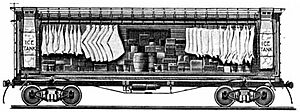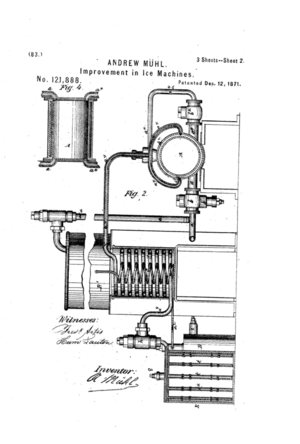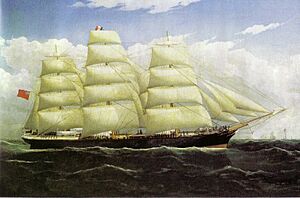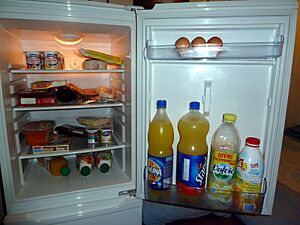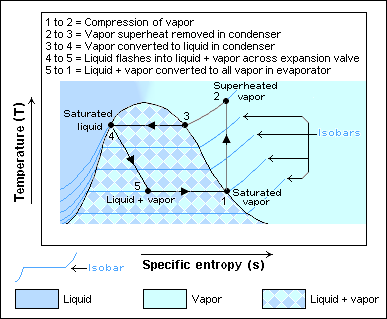Refrigeration facts for kids
Refrigeration is a way of cooling a space, a substance, or a system to make it colder and keep it at a lower temperature than its surroundings. It's a human-made method of cooling. When we refrigerate something, we remove heat from a colder place and move it to a warmer place. This usually involves machines, but it can also use heat, magnets, electricity, or even lasers! Refrigeration is used in many places, like in your home refrigerator, big industrial freezers, and air conditioning systems.
Refrigeration has changed a lot of things in our world, like industries, how we live, farming, and where people choose to live. For thousands of years, people tried to keep food fresh using salt, drying it, or storing it in cool places like caves. But they didn't have many other ways to cool things down. In the 1800s, people started using the ice trade to create "cold chains" – ways to keep things cold as they moved from one place to another.
Later, in the late 1800s and early 1900s, mechanical refrigeration was invented and got much better. This led to temperature-controlled rail cars, refrigerator trucks, and the refrigerators and freezers we see everywhere today in stores and homes. Refrigerated rail cars even helped people settle in new areas that weren't near rivers or harbors.
These new ways of keeping things cold helped big cities like Houston, Texas, and Las Vegas, Nevada, grow in places that used to be too hot to live in easily. In many countries, cities rely on refrigeration in supermarkets to get their daily food. This also meant that farms could produce much more food, leading to better nutrition for many people.
Contents
How Did Cooling Start?
Early Ways to Keep Things Cold
People have been collecting snow and ice for a very long time, even before 1000 BC. Ancient Chinese writings describe religious events for filling and emptying ice cellars. The ancient Greeks and Romans also dug large snow pits and insulated them with grass or branches to keep things cold. They mostly used ice to cool drinks, not to preserve food.
The Egyptians cooled water by letting it evaporate in shallow jars on their rooftops at night. People in ancient India used a similar idea to make ice. The Persians stored ice in a pit called a Yakhchal and might have been the first to use cold storage to keep food fresh. In Australia, before electricity was common, farmers used a Coolgardie safe. This was a room with wet burlap curtains. As the water evaporated from the curtains, it cooled the room, helping to keep foods like fruit and butter fresh.
Harvesting Natural Ice

Before the 1830s, not many Americans used ice to cool food because there weren't many ice storage places or iceboxes. As these became more common, people started cutting ice from frozen lakes and rivers using axes and saws. This was hard and dangerous work, and not easy to do on a large scale.
Despite the difficulties, a man named Frederic Tudor saw a business opportunity. He decided to harvest ice in New England and ship it to places like the Caribbean islands and the southern states. At first, he lost a lot of money. But he eventually made a profit by building icehouses in places like Charleston, Virginia, and Havana, Cuba. Better insulated ships also helped reduce how much ice melted during transport.
Tudor's success and an invention by Nathaniel Wyeth (a horse-drawn ice cutter in 1825) made ice harvesting faster and cheaper. This led to the growth of the ice trade. By the early 1830s, ice became very affordable. For example, in New York City, ice use grew from 12,000 tons in 1843 to 100,000 tons in 1856! This "cooling culture" meant most people used ice and iceboxes to store dairy products, fish, meat, and even fruits and vegetables. These early cold storage methods prepared people for the refrigeration technology that would come later.
Early Refrigeration Discoveries
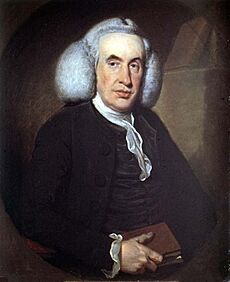
The story of artificial refrigeration began in 1755 when a Scottish professor named William Cullen designed a small cooling machine. He used a pump to create a partial vacuum over a container of diethyl ether. The ether would then boil, taking heat from the air around it. This experiment even made a tiny bit of ice, but it wasn't practical for everyday use at the time.
In 1758, Benjamin Franklin and John Hadley experimented with evaporation to cool objects quickly. They found that evaporating liquids like alcohol and ether could make an object colder than water's freezing point. Franklin even joked that you could "freeze a man to death on a warm summer's day" with this method!
In 1805, American inventor Oliver Evans described a system that could make ice using ether under a vacuum. Later, in 1820, the English scientist Michael Faraday turned ammonia and other gases into liquids using high pressures and low temperatures.
Then, in 1834, an American living in Great Britain, Jacob Perkins, built the world's first working vapor-compression refrigeration system. It was a closed system that could run continuously, meaning it could reuse the cooling liquid without waste. His machine worked, but it wasn't a commercial success.
Another American, physician John Gorrie, built a working prototype in 1842, but it also failed commercially. Gorrie believed that too much heat caused diseases like malaria. He thought his refrigeration system could cool homes and hospitals to prevent illness.
The first practical vapor-compression refrigeration system was built by James Harrison, a British journalist in Australia. His 1856 patent was for a system using ether, alcohol, or ammonia. He built an ice-making machine in 1851 and his first commercial one in 1854. Harrison also brought commercial refrigeration to breweries and meat-packing plants. By 1861, a dozen of his systems were in use.
In 1859, Ferdinand Carré of France developed the first gas absorption refrigeration system, which used ammonia gas dissolved in water. Later, Carl von Linde, a German engineer, started researching refrigeration in the 1860s and 1870s. Brewers wanted a way to make beer all year round. In 1876, Linde patented an improved way to liquefy gases. His method made it possible to use gases like ammonia and sulfur dioxide as refrigerants, and they were widely used until the late 1920s.
An American balloonist named Thaddeus Lowe also had patents for ice-making machines. His "Compression Ice Machine" was meant to change the cold-storage industry. In 1869, he tried shipping fresh fruit and meat using his refrigeration units on a steamship, but it was a costly failure because he didn't know enough about shipping.
Refrigeration in Business and Homes
Commercial Use of Refrigeration
John Gorrie's system in 1842, though not a commercial success, inspired others. Ferdinand Carre in France created a simpler ice-producing system. During the Civil War, New Orleans couldn't get ice from New England. Carre's system became the solution, and by 1865, the city had three of his machines. In Texas, Andrew Muhl built an ice-making machine in 1867 to help the growing beef industry. His patent was later used by Columbus Iron Works, which made the first commercial ice-makers in the US.
By the 1870s, breweries were the biggest users of harvested ice. However, pollution started to affect natural ice, especially in cities. People worried about diseases like typhoid fever from contaminated ice. This led to a higher demand for modern refrigeration and manufactured ice. Machines like Carre's and Muhl's became important for providing ice to stores, farmers, and food transporters.
Refrigerated railroad cars were first used in the US in the 1840s for short trips with dairy products. These early cars used harvested ice to stay cool.
The new refrigeration technology was first widely used in industry to freeze meat for transport by sea. This allowed meat to be shipped from countries like New Zealand to the United Kingdom. In 1881, William Soltau Davidson, an entrepreneur from New Zealand, had the ship Dunedin fitted with a refrigeration unit. On February 15, 1882, the Dunedin sailed for London with the first successful commercial shipment of frozen meat. This event started the refrigerated meat industry.
The Times newspaper called it "such a triumph over physical difficulties, as would have been incredible... a very few days ago." Other ships quickly followed, and within five years, 172 shipments of frozen meat were sent from New Zealand to the UK. This also led to a boom in meat and dairy production in Australia and South America.
By the 1890s, refrigeration was vital for distributing food. Meat-packing companies, like Armour, Swift, and Wilson, used commercial refrigeration systems in their plants, train cars, and storage facilities. By 1914, almost every meat-packing location used artificial refrigeration.
By the mid-1900s, refrigeration units were designed for trucks. Today, refrigerated trucks and trains transport perishable goods like frozen foods, fruits, vegetables, and sensitive chemicals. Most modern refrigerated vehicles keep temperatures between -40 and -20 °C.
However, early commercial refrigerators were too big, expensive, and unsafe for homes. Some units in 1910 weighed tons! They could catch fire, explode, or leak toxic gases. Refrigeration didn't become common in homes until these problems were solved.
Refrigeration for Homes and Consumers

In the early 1800s, people kept food fresh using iceboxes, which held food and ice bought from ice harvesters. Thomas Moore patented a metal-lined butter tub in 1803, which became the model for most iceboxes. These iceboxes were used until about 1910, but they often became moldy and smelly.
General Electric (GE) was one of the first companies to tackle these problems. In 1911, GE released a gas-powered home refrigerator. This made the refrigerator smaller because it didn't need an electric compressor motor. However, GE's electric company customers wanted an electric model. So, in 1927, GE released the Monitor Top, the first refrigerator to run on electricity.
In 1930, Frigidaire, a competitor, created Freon. This was a new, safer type of chemical for refrigeration, called a chlorofluorocarbon (CFC). Freon led to smaller, lighter, and cheaper refrigerators. The average price of a refrigerator dropped significantly, allowing more than 50% of American households to own one by 1940. Freon was considered safer than earlier refrigerants like ammonia. However, in the 1970s, scientists discovered that CFCs were harming the Earth's ozone layer, which protects us from the sun's harmful ultraviolet rays. Because of this, the use of CFCs as refrigerants was limited worldwide by the Montreal Protocol in 1987.
How Refrigeration Changed Where People Live
In the last century, refrigeration allowed people to settle in new places. This technology made it possible to live in areas that weren't near natural transportation routes like rivers or valleys. It gave early settlers chances to move westward and into rural areas that were empty before. These new settlers found rich, untouched soil and could make money by sending raw goods to cities in the east. In the 20th century, refrigeration helped "Galactic Cities" like Dallas, Phoenix, and Los Angeles grow.
Refrigerated Train Cars
The refrigerated train car, along with the growing railroad network, became a super important link between farms and markets. Before these cars, it was impossible to ship perishable foods long distances. The beef packing industry was the first to demand refrigerated cars. Railroad companies were slow to adopt them because they had already invested a lot in cattle cars and stockyards. Refrigerated cars were also complex and expensive.
Once adopted, the beef packing industry controlled the refrigerated train car business. By 1916, over 69% of cattle killed in the US were processed in plants involved in interstate trade. The same companies later used refrigerated transport for vegetables and fruit. They had the expensive machines and cold storage facilities to distribute all kinds of perishable goods. During World War I, a national refrigerated car pool was created to make sure cars were used efficiently, especially between seasonal harvests. Refrigerated train cars moved fresh produce from western states to eastern markets, making it possible to transport crops hundreds or even thousands of miles. This led to regions specializing in certain fruits and vegetables. Refrigerated train cars were widely used until the 1950s. By the 1960s, the interstate highway system was complete, and trucks took over most of the perishable food transport.
Moving West and into Rural Areas
The widespread use of refrigeration opened up many new farming opportunities in the United States. New markets appeared in areas that were previously empty and far from crowded places, especially in the southern and western states. Refrigeration allowed many areas to specialize in growing specific fruits. California became known for grapes, peaches, pears, plums, and apples, while Georgia became famous for its peaches. In California, the use of refrigerated train cars led to a huge increase in fruit shipments.
The Gulf States, Arkansas, Missouri, and Tennessee started large-scale strawberry production, and Mississippi became a center for the tomato industry. New Mexico, Colorado, Arizona, and Nevada grew cantaloupes. None of this would have been possible without refrigeration. By 1917, older fruit and vegetable areas near eastern markets felt the competition from these distant specialized centers.
Refrigeration wasn't just for meat, fruit, and vegetables; it also helped dairy farms. In the early 1900s, large cities got their dairy supply from farms as far as 400 miles away. Dairy products spoil faster than fruits and vegetables, so refrigeration was even more important for them. It made it possible for dairy farms in the west, far from eastern markets, to sell their products and even undersell their eastern competitors. Refrigeration and refrigerated trains gave opportunities to areas with rich soil that were far from natural transportation routes.
The Rise of "Galactic Cities"
The term "galactic city" describes large cities like Los Angeles, Las Vegas, Houston, and Phoenix. These cities are different because they didn't grow along natural transport routes like rivers or harbors. Several things helped these cities grow, including reliable cars, highway systems, refrigeration, and more agricultural production.
These large cities developed in areas that would have been unlivable just a few hundred years ago. Without an affordable way to cool air and transport water and food from far away, these cities would never have grown so big. The fast growth of these cities was greatly influenced by refrigeration and the increase in farm productivity, which allowed distant farms to feed the growing populations effectively.
How Refrigeration Changed Farming and Food
Farming in developed countries has changed a lot in the last century, partly because of refrigeration. Today, a small number of farms produce a large amount of agricultural sales in the United States. This is partly due to the market for frozen meat that started with the first successful shipment of frozen sheep from New Zealand in the 1880s. As this market grew, rules for food processing and quality became stricter. Eventually, electricity came to rural homes, allowing refrigeration technology to expand on farms, which increased how much food each person could produce. Today, refrigeration on farms helps reduce humidity, prevents food from spoiling due to bacteria, and helps preserve food.
Farming and People
Refrigeration and other technologies greatly changed farming in the United States. In the early 1900s, farming was a common job and lifestyle. In 1935, there were 6.8 million farms in the US. But even though the US population has grown, the number of people working in farming has gone down. Today, less than one percent of the population claims farming as their main job. However, the growing population needs more farm products, which is met by growing more types of crops, using fertilizers, pesticides, and better technology. Improved technology has made farming less risky and faster, allowing larger farms to produce more food per person to meet society's demand.
Meat Packing and Trade
Before 1882, New Zealand farmers were experimenting with different sheep breeds, which gave them a chance to export meat. In 1882, the first successful shipment of frozen sheep carcasses was sent from Port Chalmers in Dunedin, New Zealand, to London. By the 1890s, the frozen meat trade became very profitable in New Zealand. This new way of shipping led to an economic boom in New Zealand by the mid-1890s.
In the United States, the Meat Inspection Act of 1891 was put in place. When meat packing became big, people worried about the quality of the meat. Upton Sinclair's 1906 novel The Jungle highlighted unsanitary working conditions and the processing of diseased animals in the meat industry. This book caught the attention of President Theodore Roosevelt, and the 1906 Meat Inspection Act was passed. This new law focused on the quality of the meat and the cleanliness of the places where it was processed.
Electricity in Rural Areas
In the early 1930s, 90% of people in US cities had electricity, but only 10% of rural homes did. Power companies didn't think it would be profitable to extend power to rural areas. However, during the Great Depression, President Franklin D. Roosevelt realized that rural areas would stay poor and unproductive without electricity. On May 11, 1935, he signed an order creating the Rural Electrification Administration (REA). This agency provided loans to build electric infrastructure in rural areas. In just a few years, 300,000 rural homes in the US had electricity.
Electricity greatly improved working conditions on farms and made food production safer. Refrigeration systems were introduced to farms and food distribution, helping to preserve food and keep it safe. Refrigeration also allowed perishable goods to be shipped across the United States. As a result, US farmers quickly became the most productive in the world, and entirely new food systems developed.
Refrigeration on Farms Today
Today, refrigeration is used on farms for meat, produce, and dairy processing to reduce humidity and prevent spoiling from bacteria. Refrigeration systems are used most heavily in warmer months for produce, which needs to be cooled quickly to meet quality standards and last longer. Dairy farms refrigerate milk all year round to prevent it from spoiling.
How Refrigeration Changed Our Lives and Food
In the late 1800s and early 1900s, the foods people could eat depended a lot on the seasons and what could be grown nearby. Refrigeration changed this completely. It played a huge part in making modern supermarkets possible and popular. Now, you can find fruits and vegetables that are out of season or grown far away, often at low prices. Refrigerators have also led to a big increase in how much meat and dairy products people buy.
Besides changing what we buy, the ability to store food for longer periods has given people more free time. Before home refrigerators, people often had to shop daily for their meals.
Impact on Nutrition
Refrigeration allowed for clean handling and storage of perishable foods. This led to more food being produced, consumed, and better nutrition. It also helped us move away from using a lot of salt to preserve food, leading to healthier sodium levels. The ability to move and store perishable foods like meat and dairy led to an increase in dairy consumption and overall protein intake in the US after the 1890s.
People ate more of these perishable foods not just because they could store them easily, but also because innovations in refrigerated transport and storage meant less food spoiled. This drove down the prices of these products. Refrigeration has contributed to better nutrition, which has even been linked to an increase in adult height in the US. Studies have also shown a connection between having more refrigerators in homes and a lower rate of stomach cancer deaths.
How We Use Refrigeration Today
The most common uses of refrigeration today are for air conditioning in homes and public buildings, and for keeping food cold in homes, restaurants, and large warehouses. The use of refrigerators and walk-in coolers and freezers allows us to have fresh salads year-round and store fish and meats safely for long periods. The best temperature range for storing perishable food is 3 to 5 °C (37 to 41 °F).
In businesses and factories, refrigeration has many uses. It's used to turn gases like oxygen, nitrogen, and propane into liquids. In compressed air systems, it removes water vapor to reduce moisture. In oil refineries and chemical plants, refrigeration keeps certain processes at the low temperatures they need. Metalworkers use refrigeration to strengthen steel. When transporting temperature-sensitive foods and other materials by trucks, trains, airplanes, and ships, refrigeration is essential.
Dairy products always need refrigeration. It was only recently discovered that eggs need to be refrigerated during shipment, not just after they arrive at the grocery store. Meats, poultry, and fish must all be kept in controlled temperatures before they are sold. Refrigeration also helps fruits and vegetables stay edible longer.
One very important use of refrigeration was in the growth of the sushi and sashimi industry in Japan. Before refrigeration, eating raw fish carried a risk of disease. But with better refrigeration designs, refrigerators became cheaper and more available for restaurants and the public, making sushi safer to enjoy.
Different Ways to Refrigerate
Refrigeration methods can be grouped into a few types: non-cyclic, cyclic, thermoelectric, and magnetic.
Non-Cyclic Refrigeration
This method cools an area by melting ice or by using dry ice (solid carbon dioxide) which turns directly into gas. A simple example is a portable cooler where you put items and then pour ice over them. Regular ice keeps temperatures near freezing. Dry ice can make things much colder than water's freezing point.
Cyclic Refrigeration
This involves a refrigeration cycle where heat is taken from a cold place and moved to a warmer place using outside energy. This is how most refrigerators work. The cycle describes how a special liquid or gas, called a refrigerant, absorbs and releases heat as it moves through the refrigerator. This principle was first described mathematically by Sadi Carnot in 1824.
The most common types of refrigeration systems use the reverse-Rankine vapor-compression refrigeration cycle.
Cyclic refrigeration can be divided into:
- Vapor cycle
- Gas cycle
Vapor cycle refrigeration can be further divided into:
- Vapor-compression refrigeration
- Sorption Refrigeration
- Vapor-absorption refrigeration
- Adsorption refrigeration
Vapor-Compression Cycle
The vapor-compression cycle is used in most home refrigerators and many large commercial and industrial cooling systems. Look at Figure 1 to see the parts of a typical system.
Here's how it generally works: A refrigerant (a special liquid/gas) enters a compressor as a vapor. The compressor squeezes the vapor, making it hotter and increasing its pressure. Then, this hot, high-pressure vapor goes to the condenser. Here, it cools down and turns back into a liquid, releasing its heat to the outside air. Next, the liquid refrigerant passes through an expansion valve. This valve suddenly lowers the pressure, causing some of the liquid to flash into a cold vapor. Finally, this cold liquid-vapor mixture flows through the evaporator coils. As warm air from inside the refrigerator blows over these coils, the refrigerant absorbs the heat and turns completely back into a vapor. This cold vapor then returns to the compressor to start the cycle again.
This explanation is a simplified version. Real systems have small energy losses and other effects. For very low temperatures, two vapor compression systems can be linked together in a "cascade" system.
Sorption Cycle
Absorption Cycle
In the early 1900s, absorption refrigeration systems were popular, especially those using water-ammonia or lithium bromide-water. They lost popularity after vapor compression systems were developed because they are less efficient. Today, absorption systems are mainly used where there's plenty of heat available but no electricity, like in recreational vehicles that use LP gas. They are also used in factories where waste heat can power them.
The absorption cycle is similar to the compression cycle, but it uses a different way to increase the refrigerant vapor's pressure. Instead of a compressor, it uses an absorber (which dissolves the refrigerant in a liquid), a pump (which increases the liquid's pressure), and a generator (which heats the liquid to release the refrigerant vapor).
Adsorption Cycle
The main difference from the absorption cycle is that in adsorption, the refrigerant (like ammonia or water) sticks to a solid material, called an adsorbent (like silica gel or activated carbon), instead of dissolving in a liquid. Adsorption refrigeration systems are often quiet, don't cause corrosion, and are good for the environment.
Gas Cycle
When the working fluid is a gas that is compressed and expanded but doesn't change from gas to liquid (or vice versa), it's called a gas cycle. Air is often used as the working fluid. Since there's no condensation or evaporation, the parts that would be the condenser and evaporator in a vapor compression cycle are just hot and cold gas-to-gas heat exchangers.
Gas cycles are less efficient than vapor compression cycles. Because of their lower efficiency and larger size, air cycle coolers are not often used in cooling devices on land. However, air cycle machines are very common in jet aircraft for cooling and ventilation, because compressed air is easily available from the engines. These units also help to pressurize the aircraft cabin.
Thermoelectric Refrigeration
Thermoelectric cooling uses something called the Peltier effect to move heat between two different materials. This method is often found in camping coolers, portable coolers, and for cooling small electronic parts. Peltier coolers are used when a traditional refrigerator would be too big or impractical. They are also used in cooled image sensors because they are easy, compact, and lightweight, even if they are not very efficient. Peltier coolers have a lower efficiency compared to vapor-compression systems, meaning they produce more waste heat and use more power for the same amount of cooling.
Magnetic Refrigeration
Magnetic refrigeration, also known as adiabatic demagnetization, is a cooling technology based on how certain magnetic solids react to a magnetic field. The cooling material is often a paramagnetic salt.
Here's the basic idea: A strong magnetic field is applied to the cooling material, which makes its tiny magnetic parts line up. This reduces the material's internal disorder (entropy). A heat sink then absorbs the heat released by the material. Next, the material is insulated, and the magnetic field is turned off. This increases the material's ability to hold heat, which makes its temperature drop below the temperature of the heat sink.
Because only a few materials have the right properties at room temperature, this method is mostly used for very cold temperatures (cryogenics) and in research.
Other Cooling Methods
Other ways to cool things include the vortex tube (for spot cooling when compressed air is available), and thermoacoustic refrigeration (which uses sound waves in pressurized gas to move heat). Steam jet cooling was popular in the 1930s for air conditioning large buildings. Thermoelastic cooling uses a special metal alloy that changes temperature when stretched and relaxed. Many Stirling cycle engines can also work in reverse to act as refrigerators and are used in cryogenics. There are also other types of cryocoolers like Gifford-McMahon coolers and pulse-tube refrigerators.
Elastocaloric Refrigeration
Another new way to cool things uses a special property of "super elastic" materials. These materials change temperature when they are stretched or squeezed (this is called the elastocaloric effect). When a super elastic material is stretched, it heats up. When the stress is removed, it cools down by absorbing heat from its surroundings.
The exciting part about this research is that it could be very energy-efficient and good for the environment. The materials used, often shape-memory alloys like nitinol, are non-toxic and don't produce emissions. Nitinol is a promising material, showing good cooling effects. Other materials like natural rubber have also been studied. Even though rubber might not produce as much cooling per volume, it still creates a noticeable temperature change and works at suitable temperatures and low costs.
The main challenge is energy loss during the process. To make it more efficient, scientists need to fine-tune the alloys to reduce these losses and improve how well the material can go back and forth between its states. Balancing these factors could lead to a new and effective way of refrigeration.
Passive Cooling Systems
One study found that combining a passive daytime radiative cooling system with thermal insulation and evaporative cooling increased cooling power by 300% compared to just a radiative cooling surface. This could extend the shelf life of food by 40% in humid climates and 200% in desert climates without needing a refrigerator. The evaporative cooling layer would need water added every 10 days to a month in humid areas, and every 4 days in hot, dry areas.
How We Measure Cooling Power
The cooling power of a refrigeration system is how much heat it can remove. It's measured in units like kilowatts (kW) or BTU/hour. Home and commercial refrigerators might be rated in kJ/s or Btu/h. For larger industrial systems, the kilowatt (kW) is the main unit, except in North America, where "ton of refrigeration" and BTU/h are also used.
A refrigeration system's coefficient of performance (CoP) tells us how efficient it is. It's calculated by dividing the cooling power (in kW) by the energy used to run the system (in kW). A higher CoP means better efficiency. In North America, for industrial refrigeration, people often use "performance factor" (PF) instead. PF is the energy input in horsepower divided by the cooling capacity in tons of refrigeration. Both CoP and PF depend on specific operating conditions, like temperatures and how much cooling is needed. If these conditions change, the system's performance can change a lot.
Air conditioning systems for homes often use SEER (Seasonal Energy Efficiency Ratio) to rate their energy performance. Commercial air conditioning systems often use EER (Energy Efficiency Ratio) and IEER (Integrated Energy Efficiency Ratio).
|
See also
 In Spanish: Refrigeración para niños
In Spanish: Refrigeración para niños




